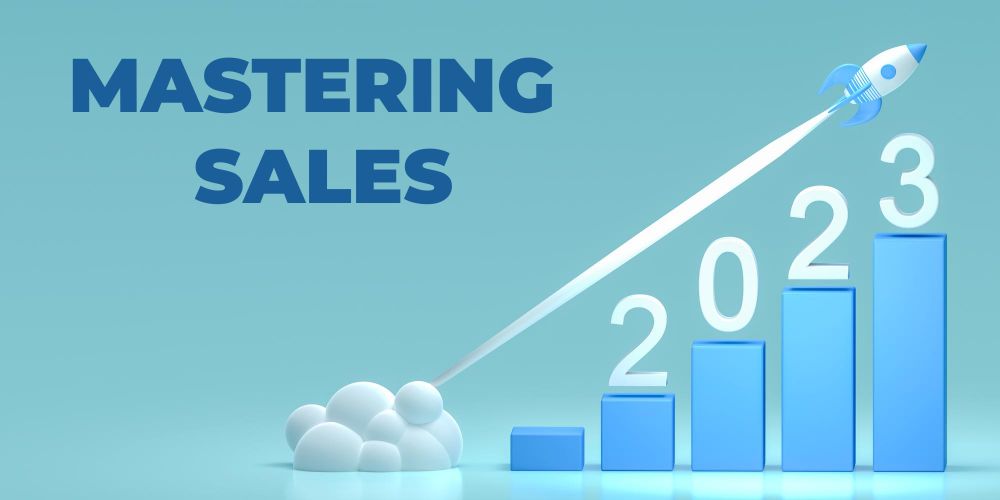
Imagine yourself in a bustling marketplace, where the air is filled with the sounds of conversations, the enticing aromas of various products, and the energy of eager customers. Amidst this vibrant atmosphere, sales professionals are navigating the dynamic sales landscape, armed with strategies to excel in the ever-evolving industry. As we step into 2023, it’s essential to understand the key trends that will shape the sales industry and master the art of adapting to these changes.
Sales is ultimately about building connections, understanding customer needs, and providing value. No matter how advanced our technology becomes, the essence of sales industry lies in the genuine human interactions and relationships that drive success. In 2023, we will strive to blend the art of connection with the power of technology, harnessing the best of both worlds to unlock the true potential of sales. These could be through sales management software or any other technology.
In this blog, we get on an exciting journey to explore nine key trends that will shape the sales landscape in 2023. We will delve into the powerful forces of technological advancements, shifts in consumer behaviors, and the demand for personalized experiences.
Throughout this blog, we will dive into each of the nine key trends shaping the sales industry in 2023. We will explore the impact of artificial intelligence and automation, the significance of personalized selling, and the value of sales enablement. We will also examine the rise of remote selling and virtual collaboration, the importance of an omnichannel approach, and the influence of influencer marketing.
We will also highlight the increasing focus on sustainable and ethical selling, the importance of customer success and retention, and the transformative potential of sales analytics and predictive insights. By understanding and mastering these trends, businesses can gain a competitive edge and thrive in the ever-changing sales landscape of 2023.
So, let’s discuss some important trends, challenges, and opportunities that lie ahead. By staying informed and adapting mentioned strategies, businesses can navigate the evolving sales industry with confidence and excellence. Let’s get started!
Top 9 Sales Trends to Watch in 2023
1. Artificial Intelligence and Automation

Artificial intelligence (AI) and automation are transforming the sales industry in remarkable ways, and their influence is set to expand even further in 2023. These cutting-edge technologies empower sales teams by automating repetitive tasks, enabling more efficient workflows, and providing valuable insights to drive decision-making.
One of the key applications of AI in the sales industry is the use of chatbots and virtual assistants. These intelligent systems can engage with customers, answer inquiries, and provide personalized recommendations, even when sales representatives are unavailable. By leveraging AI-powered chatbots, businesses can provide round-the-clock support and enhance customer experiences.
Also, predictive analytics is vital in leveraging AI for sales and sales industry success. By analyzing vast amounts of data, AI algorithms can identify patterns and trends, enabling sales teams to anticipate customer needs and preferences. This insight allows sales professionals to tailor their approach, offer relevant solutions, and increase the likelihood of successful conversions.
Lead scoring is another valuable application of AI and automation in sales. With the help of AI algorithms, businesses can analyze customer behavior, demographic data, and purchase history to assign scores to potential leads. This helps sales teams prioritize their efforts by focusing on leads that have the highest likelihood of conversion, resulting in more efficient and effective sales processes.
By embracing AI and automation, sales teams can streamline their operations, reduce manual workloads, and improve overall efficiency. This, in turn, frees up valuable time for sales professionals to focus on building relationships, providing personalized attention to customers, and offering value-added solutions.
Therefore, as we enter 2023, embracing AI and automation will be essential for sales teams to stay competitive and maximize their potential for success.
2. Personalized Selling

Today, customers are seeking more than just a transaction. They desire personalized experiences that cater to their unique needs and preferences. As a result, sales teams must shift their focus toward understanding their customers on a deeper level. By gathering and analyzing data through advanced analytics tools, companies can gain valuable insights into customer behaviors, purchasing patterns, and preferences.
Armed with this knowledge, sales teams can create highly targeted and relevant sales strategies that speak directly to the individual needs of each customer. Whether it’s through personalized product recommendations, tailored offers, or customized communication, businesses can demonstrate a genuine understanding of their customers and their specific requirements.
By delivering personalized experiences, companies can forge stronger connections and foster customer loyalty. When customers feel understood and valued, they are more likely to trust the brand and become long-term advocates. Personalized selling goes beyond the one-size-fits-all approach, allowing businesses to stand out in a crowded marketplace and build lasting relationships with their customers.
To implement personalized selling effectively, sales teams need to invest in robust data analytics tools and platforms. These technologies enable businesses to collect, analyze, and leverage customer data, helping them uncover meaningful insights and develop tailored sales strategies. By integrating personalized selling into their sales approach, businesses can enhance customer satisfaction, drive repeat sales, and gain a competitive edge in the marketplace.
3. Sales Enablement

Sales enablement is all about equipping sales teams with the right tools, content, and resources to effectively engage customers and close deals. It’s about providing them with the support they need to excel in their roles and deliver exceptional results.
As we venture into 2023, we can expect organizations to increasingly invest in sales enablement technologies and strategies. These may include content management systems, a free CRM platform, and comprehensive training resources. By implementing such tools, businesses can enhance their sales teams’ abilities to access relevant and up-to-date information, collaborate effectively, and provide value-added solutions to customers.
Sales enablement empowers sales professionals by giving them easy access to a wealth of resources, including product information, sales collateral, case studies, and customer data. With the right content at their fingertips, sales teams can effectively communicate the value of their products or services, address customer pain points, and build stronger relationships.
Additionally, sales enablement technologies, such as CRM platforms, enable sales teams to track and manage customer interactions, identify trends, and analyze data to inform their strategies. This data-driven approach helps sales professionals make informed decisions and tailor their sales approaches to individual customers, enhancing the overall customer experience.
By prioritizing sales enablement in 2023, organizations can empower their sales teams to become more efficient, effective, and customer-centric. Sales professionals equipped with the right tools and knowledge can engage customers with confidence, provide tailored solutions, and ultimately close deals more successfully.
4. Remote Selling and Virtual Collaboration

The COVID-19 pandemic has transformed the way we work and interact, pushing businesses to rapidly adopt remote work practices. In 2023, the sales industry will continue to embrace the trend of remote selling, recognizing its potential and the opportunities it presents. Remote selling refers to the process of engaging with customers, presenting products or services, and closing deals, all done through virtual platforms and digital channels.
Sales teams will need to adapt their strategies to effectively engage and build relationships with customers in a virtual environment. The days of face-to-face meetings and in-person presentations have given way to video conferencing, virtual product demonstrations, and online presentations. These remote selling techniques enable sales professionals to connect with clients regardless of geographical boundaries, opening up new markets and expanding their reach.
To succeed in remote selling, sales teams must master the art of utilizing. Virtual interactions can lack the personal connection and nonverbal cues of in-person meetings, but by leveraging the right tools and techniques, sales professionals can bridge that gap. Engaging storytelling, active listening, and effective communication become paramount in capturing the attention and interest of potential customers.
Video conferencing platforms, such as Zoom or Microsoft Teams, have become essential tools for remote selling. These platforms allow for face-to-face interactions, fostering a sense of trust and connection despite the physical distance. Virtual product demos and online presentations have also become indispensable in the remote selling landscape. Sales professionals can leverage multimedia content, such as videos, interactive slideshows, and 3D visualizations, to showcase their products or services to potential customers. By providing immersive and engaging experiences, sales teams can effectively communicate the value and benefits of their offerings.
However, it’s important to note that successful remote selling goes beyond just the technology. Sales professionals must actively listen to customers’ needs, understand their pain points, and tailor their presentations accordingly. Building rapport and establishing a genuine connection with customers is still essential, even in a virtual setting. Virtual collaboration tools, such as project management platforms and communication channels, enable sales professionals to work together seamlessly, regardless of their physical locations. This facilitates knowledge sharing, enhances team collaboration, and allows for collective problem-solving.
5. Omnichannel Sales Approach
An omnichannel approach means that sales teams integrate their sales processes, data, and communication channels to create a cohesive customer journey. It ensures that customers receive a consistent experience regardless of the channel they choose to engage with. For example, a customer might start researching a product on the company’s website, ask a question on social media, and then visit a physical store to make a purchase. With an omnichannel approach, the customer’s information, preferences, and interactions are seamlessly shared across these channels, enabling a personalized and convenient experience.
By adopting an omnichannel sales approach, organizations can effectively engage customers, build trust, and enhance the overall customer experience. It allows for a smoother transition between different touchpoints, reducing any potential friction or confusion that may arise. This approach enables sales teams to tailor their messaging and offerings based on the customer’s preferences and previous interactions, leading to increased engagement and higher conversion rates. They can use an omnichannel messaging platform or chat applications for the same.
This approach provides valuable insights into customer behavior and preferences. By collecting and analyzing data from multiple channels, sales teams can gain a comprehensive understanding of their customers’ journeys and preferences. This knowledge can inform marketing strategies, product development, and customer service initiatives, resulting in more targeted and effective sales efforts. Embracing the omnichannel approach is key to staying competitive and maximizing sales success in the evolving sales landscape.
6. Influencer Marketing

Influencer marketing involves partnering with popular individuals in specific niches, known as influencers, who have a significant following and influence over their audience. These influencers could be social media personalities, bloggers, vloggers, or industry experts. By collaborating with influencers, businesses can tap into their large and engaged audiences, leveraging their credibility and trust to promote products or services. Influencers have built a loyal following based on their expertise, authenticity, and relatability. When they endorse a product or service, their followers are more likely to trust their recommendation and consider making a purchase.
In 2023, we will witness an increased emphasis on building authentic relationships with influencers. This means moving beyond simple paid partnerships and focusing on establishing genuine connections based on shared values and mutual interests. Businesses will seek to collaborate with influencers who align with their brand values and have an authentic connection to their products or services.
The power of influencer marketing lies in its ability to expand the reach of a business and tap into niche markets that might be otherwise difficult to access. By partnering with influencers who cater to specific target audiences, businesses can effectively target their ideal customers and generate more leads. The influencer’s endorsement acts as a powerful word-of-mouth recommendation, making potential customers more likely to engage with the brand and convert into paying customers.
7. Sustainable and Ethical Selling
Sales teams need to recognize the importance of sustainability, social responsibility, and ethical sourcing in their messaging and approach. By showcasing their commitment to making a positive impact on the planet and society, businesses can attract and retain socially conscious customers who are actively seeking products and services that align with their values.
To effectively implement sustainable and ethical selling practices, sales teams should educate themselves on the environmental and social impact of their products or services. They should be prepared to address customers’ concerns and provide transparent information about the company’s efforts to reduce its carbon footprint, promote fair trade, support local communities, or engage in other socially responsible initiatives.
By incorporating sustainability and ethics into their sales strategies, companies can not only enhance their brand reputation but also tap into a growing market segment of environmentally and socially conscious consumers. These customers are willing to support businesses that align with their values, making sustainable and ethical selling a powerful differentiating factor in the competitive sales landscape.
8. Customer Success and Retention

In the coming year, businesses will prioritize customer success and shift their sales approach from purely transactional to customer-centric. Instead of viewing customers as one-time buyers, sales teams will strive to build long-term relationships and provide ongoing support throughout the customer journey.
Exceptional customer experiences will be at the forefront of sales strategies. This entails going above and beyond to understand and address the unique needs of each customer. Sales professionals will invest time and effort into building a deep understanding of their customers’ pain points, goals, and preferences, allowing them to offer personalized solutions and tailored recommendations.
Moreover, proactive communication will play a pivotal role in customer success and retention. Sales teams will keep the lines of communication open, reaching out to customers to check in, offer assistance, and address any concerns. This proactive approach not only strengthens the customer relationship but also demonstrates a genuine commitment to their success.
In addition to exceptional experiences and proactive communication, businesses will focus on providing ongoing support to their customers. This may involve offering resources, training programs, or regular check-ins to ensure customers are fully utilizing their purchases and achieving their desired outcomes. They can do so by choosing reliable and efficient Customer Service Management Software. By continuously supporting and empowering customers, businesses can foster loyalty and create advocates who not only stay with the company but also recommend it to others.
9. Sales Analytics and Predictive Insights

In 2023, sales teams will embrace the power of advanced analytics and predictive insights to gain a deeper understanding of their customers and the market. By harnessing the wealth of customer data available, sales professionals can identify patterns, trends, and opportunities that would have otherwise gone unnoticed.
Through robust data analysis, sales teams can anticipate customer needs and preferences, allowing them to deliver personalized interactions and tailored solutions. This level of personalization builds stronger connections with customers and increases the likelihood of successful sales conversions.
One of the key benefits of sales analytics is its ability to improve sales forecasting accuracy. By analyzing historical sales data alongside external market factors, sales teams can predict future sales trends with greater precision. This empowers businesses to plan resources, set realistic targets, and make strategic decisions based on reliable projections.
The integration of predictive insights takes sales analytics a step further by leveraging algorithms and machine learning to anticipate customer behavior. By analyzing vast amounts of data, such as past purchase history, browsing patterns, and demographic information, predictive models can generate actionable insights. These insights enable sales professionals to proactively engage customers, offer personalized recommendations, and make timely interventions that drive sales.
Wrapping Up!
As we conclude our exploration of the nine key trends shaping the sales industry in 2023, it becomes clear that mastering the sales landscape requires a delicate balance between embracing technology and nurturing human connections.
The key takeaways from our journey are twofold.
First, staying abreast of the latest trends and leveraging technology can help sales professionals optimize their strategies, streamline processes, and deliver exceptional customer experiences. However, it is crucial to remember that sales is fundamentally a people-centric discipline.
Second, building genuine connections, understanding customer needs, and providing personalized solutions are the foundations of successful sales.
As we look to the future, sales professionals must continually adapt and evolve, embracing the changes and challenges that lie ahead. By embracing the trends shaping the sales landscape in 2023 and applying them, businesses can forge stronger relationships, drive customer loyalty, and achieve remarkable sales success.